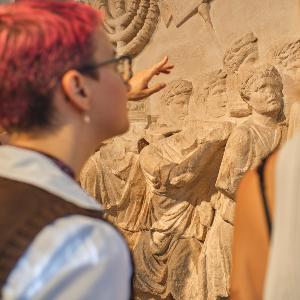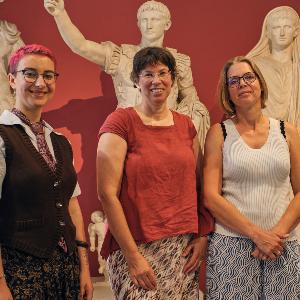New lease of life for ancient plaster casts
23 Aug 2024
A seminar combines innovative cellphone games with historical knowledge about ancient Rome. Eight history/archeology students took part – and loved the experience.
23 Aug 2024
A seminar combines innovative cellphone games with historical knowledge about ancient Rome. Eight history/archeology students took part – and loved the experience.
It is basically a digital treasure hunt, but “Mission Game” sounds way more exciting – certainly, you would think, for the youngsters who visit the Museum of Casts of Classical Statues in Munich on school outings in the future. This summer semester, the museum was host to an innovative seminar for students of all semesters. The goal was to give a new lease of life to ancient plaster casts with ideas for exciting digital games.
The challenge is formidable: “It’s about keeping ancient history visible in new media and on the threshold between analog and digital spaces,” says Dr. Denise Reitzenstein from LMU’s Historical Seminar, who devised the concept for the practice-based seminar in conjunction with the museum’s directors Dr. Andrea Schmölder-Veit and Dr. Nele Schröder-Griebel.
The initiative has received funding under the two-year “kultur.digital.strategie” program by the Bavarian State Ministry of Science and the Arts, which helps museums, libraries, archives, and theaters develop digital strategies – including the Museum of Casts, which has been something of a hidden gem for Munich residents and tourists alike.
We have ancient artifacts from all over the world.Andrea Schmölder-Veit , Director of the museum

“It was all about making the plaster come alive,” says Marianthi Grohmann, who took part in the seminar. | © LMU/LC Productions
Founded in 1869, the museum contains around 2,000 plaster casts of sculptures, coins, and gems. From the outset, the collection was intended primarily to serve the needs of research and teaching. “We have ancient artifacts from all over the world,” says Dr. Schmölder-Veit. And yet word has not necessarily got around about the existence of this resource. Who knew that you could admire a full-size cast of the Winged Victory of Samothrace, the original of which is in the Louvre, in the center of Munich – albeit in plaster and not in marble?
Latin and history classes from the Munich area make up a large part of the museum’s visitors, along with curious members of the public who want to sketch or just admire ancient objects. And of course students and scientists like Marianthi Grohmann, who appreciates that the museum and the Institute of Classical Archeology, with its large library, are located under one roof. She likes the informal atmosphere of the house and found the “creative freedom” of the seminar inspiring: “It was all about making the plaster come alive.”
To this end, the participants sought out objects in the Roman section, explored them with the scholarly methods of archeology and history, and finally considered how to get young people interested in the objects.
In the course of the seminar, the participants also tested the Mission Games offered in the Bavarian National Museum and the State Museum of Egyptian Art. The idea was to convey knowledge about ancient Rome in the Museum of Casts through positive, fun experiences using augmented reality and other technologies.
Grohmann chose the Roman Emperor Constantine the Great and suggested a dress-up game that recalls the online games she herself liked when she was at school. The name of her project was “The Emperor’s New Clothes.” Using an app, the players get Emperor Constantine dressed for various occasions. He might don the uniform of a military leader, wear a toga to visit a temple, or get rigged out for a trip to the countryside. And so the players learn a great deal not only about the emperor himself and the historical context in which he lived, but also about clothing, style, and fashion in the Roman Empire in late antiquity.
A huge variety of game ideas have since been mooted: games about propaganda in Imperial Rome, for example, or adventure games where the players have to catch thieves or find herbal medicines.
The seminar participants will further develop the project after the summer vacation. Grohmann and her fellow students Nora Schwaabe and Fiora Brehme will continue to be on the team. The goal is for museum visitors to be able to play Mission Game on their own devices. To this end, the museum plans to utilize the Actionbound app, which the Goethe Institute and the Deutsches Museum already use. “When it comes to implementation, it makes sense to concentrate on methods that have proven themselves in practice,” says Grohmann.
Tutorials, seminars, and lectures normally involve teaching specific knowledge to interested students. But it’s just as important that students and professors show the next generation how interesting and multifaceted the ancient world was – and inspire some of them to explore our beautiful museums.”Nora Schwaabe , student, is working on the “Mission Game” project
Nora Schwaabe was impressed by the seminar format: “Tutorials, seminars, and lectures normally involve teaching specific knowledge to interested students,” she explains. “But it’s just as important that students and professors show the next generation how interesting and multifaceted the ancient world was – and inspire some of them to explore our beautiful museums.” She is looking forward to seeing the end result “and hopefully play a game or two herself. It’d be especially nice to recognize the influence of my ideas on the Mission Game.”
Meanwhile, Fiora Brehme praises the opportunity to acquire practical experience in museum work: “It was great that we were able to develop and contribute our own ideas.”
We hope the project brings real added value for young people. We’re always looking to bring more attention to our museum. And we want our visitors to have many exciting, interactive experiences here.Nele Schröder-Griebel, Director of the museum

Marianthi Grohmann, Andrea Schmölder-Veit and Nele Schröder-Griebel (from left) | © LMU/LC Productions
By combining analog with digital contents, the museum wants to “get more people to engage with ancient art and culture. After all, this creates new perspectives, changes and broadens horizons, and has positive effects on society,” the museum’s website explains.
“It was lots of fun with the students,” says Andrea Schmölder-Veit. And Nele Schröder-Griebel adds: “We hope the project brings real added value for young people. We’re always looking to bring more attention to our museum. And we want our visitors to have many exciting, interactive experiences here.”
Museum für Abgüsse klassischer Bildwerke München: Website (German only)